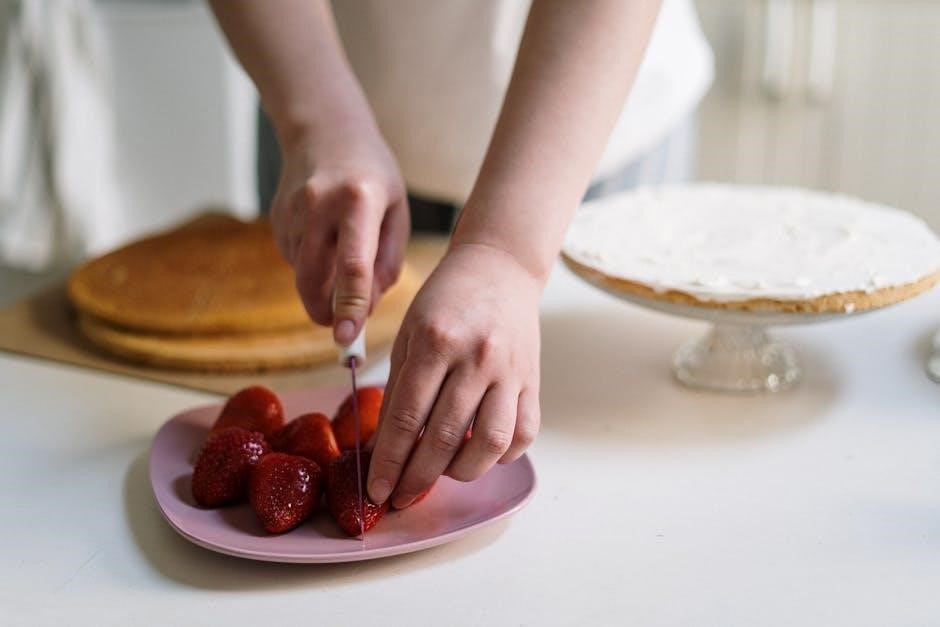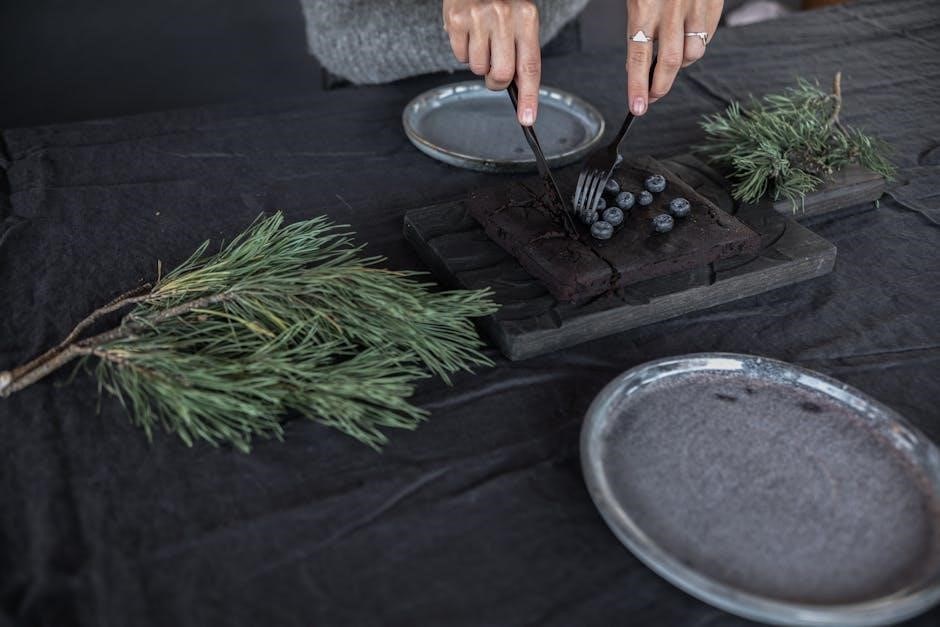Sheet cake cutting is an essential skill for bakers and event planners, offering ease and versatility in serving large groups. This guide covers tools, techniques, and tips for achieving perfect, even slices every time, ensuring professional and appealing results.
1.1 Importance of Proper Cutting Techniques
Proper cutting techniques are crucial for achieving even, visually appealing slices of sheet cake. They ensure consistency in portion sizes, making it easier to serve guests uniformly. Poor cutting can result in uneven slices, wasting cake and creating an unprofessional appearance. By mastering these techniques, you maintain the cake’s integrity and presentation, especially for events like weddings or celebrations. Additionally, clean cuts reduce crumbs and mess, making serving more efficient. Proper methods also help in achieving precise portion control, which is essential for catering to special dietary needs or preferences. overall, mastering cutting techniques enhances both the practicality and aesthetic appeal of serving sheet cakes.
1.2 Overview of Tools and Equipment Needed
To effectively cut a sheet cake, you’ll need a few essential tools and equipment. A sharp, long serrated knife is ideal for making clean cuts, while a straight-edged knife works well for trimming or creating decorative edges. A sturdy cutting board or cake stand provides a stable surface for cutting. Serving utensils like a cake server or spatula are necessary for transferring slices. Optional equipment includes a cake turntable, which allows easy access to all sides of the cake, and cutting guides or templates for precise portion control. Having these tools ensures smooth, even cuts and a professional presentation, making the process both efficient and visually appealing.
Tools and Equipment for Cutting Sheet Cakes
A long serrated knife, straight-edged knife, cutting board, cake server, and turntable are essential for cutting sheet cakes. These tools ensure precise, even, and professional results.
2.1 Essential Tools: Knives, Cutting Boards, and Serving Utensils
A long serrated knife is ideal for cutting sheet cakes, as it glides smoothly through the cake without tearing. A straight-edged knife is also useful for clean, precise cuts. Always use a sturdy cutting board to provide a stable surface for slicing. A cake server or spatula is essential for transferring slices to plates. Optional tools like a turntable can improve accessibility and evenness. Ensure all tools are sharp and clean to prevent crumbs and frosting from spreading unevenly. Proper maintenance of knives and utensils is key for achieving professional results. These tools form the foundation for efficient and attractive sheet cake cutting.
2.2 Optional Equipment: Cake Turntables and Cutting Guides
For more precise and efficient cutting, consider using optional equipment like cake turntables and cutting guides. A turntable allows easy rotation of the cake, ensuring even access to all sides and reducing strain during slicing. Cutting guides, such as adjustable templates or wire cutters, help create uniform slices, especially for large or intricate cakes. These tools are particularly useful for professional bakers or those hosting events where presentation matters. While not essential, they enhance accuracy and speed, making the cutting process smoother and the results more visually appealing. Investing in these can elevate your sheet cake cutting experience and ensure consistent, elegant portions.

Basic Cutting Techniques for Sheet Cakes
Mastering straight cuts and exploring angled techniques ensures even, visually appealing slices. These methods emphasize precision and creativity, making sheet cake serving both efficient and elegant.
3.1 Straight Cuts: Achieving Even Slices
Mastering straight cuts is fundamental for achieving even, uniform slices in sheet cakes. Start by ensuring the cake is completely cooled and leveled to prevent unevenness. Use a serrated knife or cake cutter for clean, precise cuts. Place the cake on a sturdy cutting board or turntable for stability. Measure and mark the cake surface with light guidelines to ensure consistency in slice size. Apply gentle, consistent pressure while cutting in smooth, steady strokes. This technique minimizes crumbs and ensures professional-looking portions. For larger cakes, consider using a cake guide or template to maintain uniformity. Straight cuts are ideal for both casual gatherings and formal events, offering neat and visually appealing results.
3.2 Diagonal and Angled Cuts for Unique Portions
Diagonal and angled cuts add creativity and visual appeal to sheet cake servings. To achieve these cuts, position the cake on a turntable for better access and control. Using a serrated knife, start at one corner and cut diagonally or at an angle across the cake. This technique creates unique, triangular-shaped slices that stand out. For consistent results, mark guidelines on the cake surface before cutting. Angled cuts are ideal for decorative presentations, such as weddings or themed events. They also allow for varying portion sizes while maintaining an elegant appearance. Experiment with different angles to create a visually striking arrangement that enhances the overall appeal of the cake.
Determining Serving Sizes
Determining serving sizes ensures efficient portion control and even distribution. Standard sheet cake portions are typically 2×2 inches. Adjust sizes for special diets or preferences easily.
4.1 Standard Serving Sizes for Sheet Cakes
Standard serving sizes for sheet cakes are typically designed to ensure uniformity and ease of portion control. A common size for a serving is a slice measuring 2×2 inches, which provides a generous yet manageable portion. For larger gatherings, slices can be slightly smaller, around 1.5×2 inches, to maximize the number of servings. The thickness of the cake also plays a role, with most standard slices being about 1 inch thick. This sizing ensures that each guest receives an equal and visually appealing portion. Using a consistent cutting technique helps maintain these standards, making the serving process efficient and professional.
4.2 Adjusting Portions for Special Diets or Preferences
When accommodating special diets or preferences, portion sizes for sheet cakes can be tailored to meet individual needs. For example, smaller slices (1×2 inches) are ideal for low-calorie or sugar-free diets, while larger portions (2.5×2 inches) can be offered for heartier appetites. Vegan or gluten-free cakes may require adjusted cutting techniques to maintain structural integrity. Using a serrated knife and gentle sawing motions helps prevent crumbling. Additionally, offering bite-sized portions (1×1 inches) can cater to guests with dietary restrictions or younger attendees. Clear labeling of each portion size ensures transparency and helps guests make informed choices, making the serving process inclusive and accommodating for all. This flexibility enhances the overall dining experience while maintaining presentation and flavor integrity.

Cutting Sheet Cakes for Special Occasions
Sheet cakes for special occasions like weddings or birthdays require precise cutting to ensure uniform slices and a polished presentation. A serrated knife and turntable are essential tools for clean, even cuts, while pre-marking the cake with toothpicks can help achieve consistent portion sizes. For weddings, creating elegant, identical slices is key, while birthday cakes might allow for more creative cuts, such as angled or decorative patterns. Freezing the cake slightly before cutting can reduce crumbs and improve results, making the cake a stunning centerpiece for any celebration.
5.1 Birthday and Celebration Cakes
Birthday and celebration cakes are perfect for sheet cake cutting, offering versatility in portion sizes and designs. For such occasions, straight cuts are ideal for uniform slices, while diagonal or angled cuts can add visual appeal. Using a serrated knife ensures clean edges, and a turntable allows easy access to all sides of the cake. Pre-marking the cake with toothpicks helps achieve consistent slices, and freezing the cake slightly can minimize crumbs. These techniques ensure that every guest receives a well-presented portion, making the cake a memorable part of the celebration. Additionally, creative cutting can match the cake’s design, enhancing the overall festive atmosphere.
5.2 Wedding and Event Cakes: Uniform and Elegant Slices
For weddings and large events, achieving uniform and elegant slices is crucial for both presentation and efficiency. A serrated knife is essential for clean cuts, while a cake turntable allows easy access to all sides. Freezing the cake slightly can help prevent crumbs and ensure precise cuts. Standard portion sizes, typically 1×2 inches, are recommended for consistency. Using a cutting guide or template can help maintain uniformity, especially for intricate designs. Additionally, pre-marking the cake with toothpicks or a sharp knife can guide even cuts. This method ensures every slice looks professional and serves guests effortlessly, making the cake a highlight of the event.

Tips for Achieving Clean, Even Cuts
Achieving clean, even cuts requires sharp tools, gentle pressure, and a steady hand. Freeze the cake slightly for easier slicing and use guides for uniformity.
6.1 Using the Right Knife and Maintenance
Using the right knife is crucial for clean, even cuts. A serrated or offset knife is ideal for sheet cakes, as it glides smoothly through the layers. Regular sharpening ensures precision and prevents tearing. After use, clean the knife thoroughly with soap and water, and dry it to avoid rust. Proper storage in a protective sheath or block extends its lifespan. Dull knives require more pressure, increasing the risk of uneven slices. Maintenance also involves avoiding cross-contamination, especially when cutting for large groups or special occasions. A well-maintained knife guarantees professional results, making it a vital tool in your cake-cutting arsenal.
6.2 Freezing the Cake for Easier Cutting
Freezing a sheet cake for about 30 minutes before cutting can significantly improve the ease and cleanliness of the process. This step firms the cake, reducing crumb dispersion and making it easier to achieve sharp, even edges. Place the cake on a sturdy surface, such as a cutting board, and ensure it is wrapped tightly in plastic wrap or aluminum foil to prevent drying out. Freezing also helps maintain the cake’s structure, especially for layered or filled varieties. Once frozen, use a serrated knife to make smooth, controlled cuts. This technique is particularly useful for large events or intricate designs, ensuring professional-looking results with minimal effort.

Common Mistakes to Avoid
Common mistakes include cutting too quickly and applying excessive pressure, leading to uneven slices. Ensure the cake is properly chilled and use a sharp knife for clean cuts.
7.1 Cutting Too Quickly or Applying Too Much Pressure
Cutting too quickly or applying excessive pressure can result in uneven slices and a messy appearance. This mistake often occurs when rushing to serve a large group or when the cake is not properly chilled. Using too much force can cause the knife to tear the cake instead of making a clean cut, especially if the blade is dull. To avoid this, ensure the cake is frozen slightly to firm up the structure, and use a sharp, serrated knife. Apply gentle, consistent pressure and make slow, steady cuts. This approach ensures even portions and maintains the cake’s integrity for a professional finish.
7.2 Not Using a Turntable for Even Access
Not utilizing a turntable while cutting a sheet cake can lead to uneven slices and hinder access to all parts of the cake. A turntable facilitates easy rotation, ensuring each cut is consistent and precise. Without it, reaching certain areas becomes challenging, often resulting in irregularly sized portions. This inconsistency can be particularly noticeable at events or social gatherings where both presentation and equitable serving sizes are crucial. Moreover, not using a turntable may lead to wasted cake due to uneven cuts and can make the cake appear less professional. To enhance your cake-cutting experience and achieve uniform, visually appealing slices, consider investing in a reliable cake turntable. It not only streamlines the cutting process but also ensures that every guest receives an equally sized portion, maintaining the overall aesthetic appeal of the cake.
Mastering the art of sheet cake cutting is a valuable skill for anyone hosting events or baking professionally. By understanding proper techniques, selecting the right tools, and avoiding common mistakes, you can ensure clean, even slices every time. Whether for celebrations, weddings, or casual gatherings, a well-cut sheet cake enhances both presentation and guest satisfaction. Remember, practice makes perfect, so don’t hesitate to experiment and refine your skills. With the right approach, you’ll deliver professional-looking results that impress and satisfy. Happy baking and cutting!
